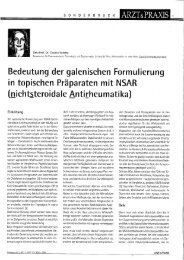Diclofenac Sodium 4% Spray Gel - cyathus.cz
Diclofenac Sodium 4% Spray Gel - cyathus.cz
Diclofenac Sodium 4% Spray Gel - cyathus.cz
Create successful ePaper yourself
Turn your PDF publications into a flip-book with our unique Google optimized e-Paper software.
PAR <strong>Diclofenac</strong> <strong>Sodium</strong> <strong>4%</strong> <strong>Spray</strong> <strong>Gel</strong><br />
UK/H/0562-3/001/E01<br />
<strong>Diclofenac</strong> <strong>Sodium</strong> 4 % <strong>Spray</strong> <strong>Gel</strong> contains peppermint oil which may cause<br />
allergic reactions.<br />
4.5 Interactions with other medicinal product and other forms of interaction<br />
The systemic availability of diclofenac from this pharmaceutical presentation<br />
is very low. Hence the risk of interactions with other medicinal products is<br />
small. Concurrent aspirin or other NSAIDs may result in an increased<br />
incidence of adverse reactions.<br />
4.6 Pregnancy and lactation<br />
There is insufficient experience for the use during pregnancy and lactation.<br />
Therefore the use is not recommended.<br />
Use in pregnancy: No evidence of a malformative effect was observed with<br />
diclofenac. However, additional epidemiological data is necessary to assess<br />
safety. During the last trimester of pregnancy, the use of prostaglandin<br />
synthetase inhibitors may result in:<br />
- pulmonary and cardiac toxicity in the foetus (pulmonary hypertension with<br />
preterm closing of the ductus arteriosus)<br />
- renal insufficiency in the foetus with oligohydramnios<br />
- and increased possibility of bleeding in the mother and child.<br />
Therefore, <strong>Diclofenac</strong> <strong>Sodium</strong> 4 % <strong>Spray</strong> <strong>Gel</strong> should be used with caution and<br />
only if clearly necessary during the first six months of pregnancy and must not<br />
be applied to a large area of the skin (i.e. more than 600 square centimetres of<br />
the body surface). It must not be used for long-term treatment (> three weeks).<br />
Treatment with <strong>Diclofenac</strong> <strong>Sodium</strong> 4 % <strong>Spray</strong> <strong>Gel</strong> is contraindicated during<br />
the last trimester of pregnancy.<br />
Use during lactation: It is not expected that any measurable amount of<br />
diclofenac will occur in breast milk following topical application. However,<br />
NSAIDs are excreted in human milk. Therefore <strong>Diclofenac</strong> <strong>Sodium</strong> 4 % <strong>Spray</strong><br />
<strong>Gel</strong> is not recommended for use in nursing mothers. An application to the<br />
breast area of nursing mothers is contraindicated.<br />
In preclinical studies of toxicity to reproduction, diclofenac showed adverse<br />
effects (see section 5.3).<br />
4.7 Effects on ability to drive and use machines<br />
Patients who experience dizziness or other central nervous disturbances while<br />
taking NSAIDs should refrain from driving or operating machinery, but this<br />
would be very unlikely using topical preparations.<br />
4.8 Undesirable effects<br />
Skin disorders are commonly reported.<br />
Skin: Application site reactions, rashes, pruritus and urticaria, drying,<br />
reddening, burning sensations, contact dermatitis.<br />
7



